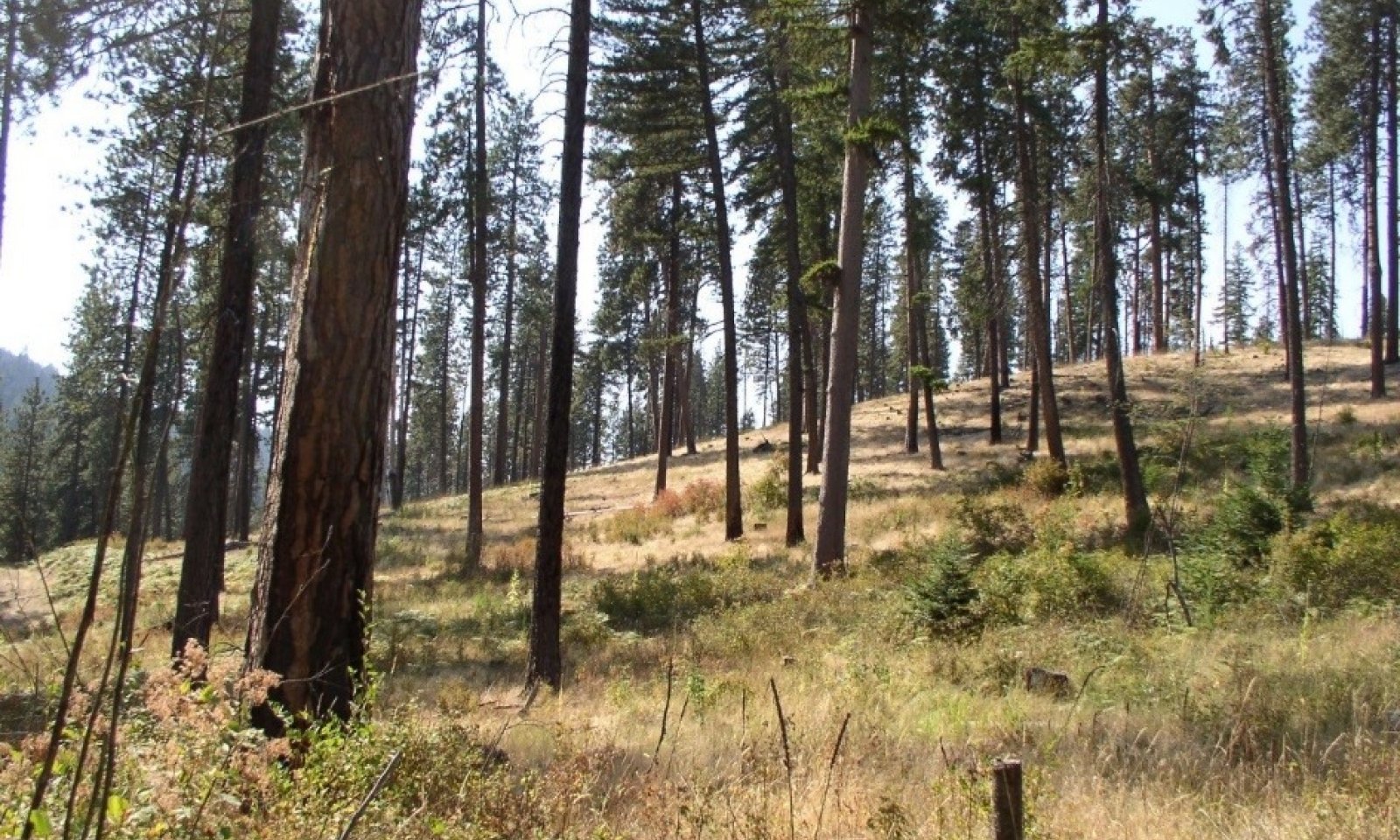

Natural Resources
Conservation Service
Ecological site F043AY547ID
Fragipan Foothills 24-30" PZ Frigid Eastern Columbia Plateau Embayments
Last updated: 3/11/2025
Accessed: 04/27/2025
General information
Provisional. A provisional ecological site description has undergone quality control and quality assurance review. It contains a working state and transition model and enough information to identify the ecological site.
MLRA notes
Major Land Resource Area (MLRA): 043A–Northern Rocky Mountains
Major Land Resource Area (MLRA): 043A–Northern Rocky Mountains
Description of MLRAs can be found in: United States Department of Agriculture, Natural Resources Conservation Service. 2006. Land Resource Regions and Major Land Resource Areas of the United States, the Caribbean, and the Pacific Basin. U.S. Department of Agriculture Handbook 296.
Available electronically at: http://www.nrcs.usda.gov/wps/portal/nrcs/detail/soils/ref/?cid=nrcs142p2_053624#handbook
LRU notes
Most commonly found in LRU 44A07 (Eastern Columbia Plateau Embayments). Also found in adjacent areas of 43A09 (Western Bitterroot Foothills). Climate parameters were obtained from PRISM and other models for the area. Landscape descriptors are derived from USGS DEM products and their derivatives.
Classification relationships
Relationship to Other Established Classifications:
United States National Vegetation Classification (2008) – A3362 Abies grandis – Pseudotsuga menziesii Central Rocky Mountain Forest & Woodland Alliance
Washington Natural Heritage Program. Ecosystems of Washington State, A Guide to Identification, Rocchio and Crawford, 2015 – Northern Rocky Mountain Mesic Montane Mixed Conifer Forest
Description of Ecoregions of the United States, USFS PN # 1391, 1995 - M333 Northern Rocky Mt. Forest-Steppe-Coniferous Forest-Alpine Meadow Province
Level III and IV Ecoregions of WA, US EPA, June 2010 – 15x Okanogan Highland Dry Forest, 15y Selkirk Mountains, 15v Northern Idaho Hills and Low Relief Mountains.
This ecological site includes the following USDA Forest Service Plant Association: ABRG/PHMA, (Williams et. al. 1995)
Ecological site concept
This ESD is distinguished by an overstory of grand fir and Douglas-fir and an understory shrub component of ninebark, oceanspray, snowberry and /or twinflower. It occurs on mountainsides. These soils have developed in thin or mixed Mazama tephra deposits over loess and Tertiary age alluvium from mixed sources. The soils are moderately deep or deep to a fragipan and have adequate available water capacity to a depth of 40 inches. The soils are moderately well-drained. They a have a water table within 30 inches of the surface during the winter months but are usually dry from June to November. This ESD fits into the National Vegetation Standard’s Grand Fir - Douglas-fir Central Rocky Mountain Forest & Woodland Alliance and Washington State’s Natural Heritage Program’s Northern Rocky Mt. Mesic Montane Mixed Conifer Forest.
Table 1. Dominant plant species
| Tree |
(1) Pseudotsuga menziesii var. glauca |
|---|---|
| Shrub |
(1) Physocarpus malvaceus |
| Herbaceous |
(1) Galium trifidum |
Physiographic features
Physiographic Features
Landscapes: Foothills, Plateaus
Landform: hillslopes, broad interfluves
Elevation (m): Total range = 690 to 1050 m
(2,265 to 3,445 feet)
Central tendency = 825 to 915 m
(2,705 to 3,000 feet)
Slope (percent): Total range = 0 to 35 percent
Central tendency = 5 to 15 percent
Aspect: none dominant
Table 2. Representative physiographic features
| Landforms |
(1)
Foothills
> Hillslope
(2) Plateau > Interfluve |
|---|---|
| Flooding frequency | None |
| Ponding frequency | None |
| Elevation | 824 – 914 m |
| Slope | 5 – 15% |
| Water table depth | 66 cm |
| Aspect | Aspect is not a significant factor |
Table 3. Representative physiographic features (actual ranges)
| Flooding frequency | None |
|---|---|
| Ponding frequency | None |
| Elevation | 690 – 1,050 m |
| Slope | 0 – 35% |
| Water table depth | 36 – 203 cm |
Climatic features
Climatic Features
Frost-free period (days): Total range = 95 to 135 days
Central tendency = 110 to 120 days
Mean annual precipitation (cm): Total range = 515 to 1020 mm
(20 to 40 inches)
Central tendency = 705 to 830 mm
(28 to 33 inches)
MAAT (C): Total range = 6.5 to 8.9
(44 to 48 F)
Central tendency = 7.4 to 8.0
(45 to 46 F)
Climate Stations: (CoOp stations) Deary, Plummer 3 WSW, Potlatch 1 SE, Princeton 5 SE
Influencing water features
Water Table Depth: perched water table at 14 to 25 inches (median = 18 inches) during Dec-Apr
at 26 to 80 inches from Apr-May (median = 26 inches)
generally dry after mid-June
Flooding:
Frequency: None
Duration: None
Ponding:
Frequency: None
Duration: None
Soil features
Representative Soil Features
This ecological subsite is associated with several soil series (e.g. Santa, Carlinton, Pold, and Teakean). The soil components are: Vitrandic Fragixeralfs, Aquic Vitrixerands, and Vitrandic Palexeralfs. These soils have developed in thin or mixed Mazama tephra deposits over loess and Tertiary age alluvium from mixed sources. The soils are moderately deep or deep to a fragipan and have adequate available water capacity to a depth of 1 m. The soils are moderately well-drained.
Table 4. Representative soil features
| Parent material |
(1)
Volcanic ash
(2) Alluvium (3) Loess (4) Colluvium – metamorphic rock |
|---|---|
| Surface texture |
(1) Ashy silt loam |
| Drainage class | Moderately well drained |
| Permeability class | Very slow to slow |
| Depth to restrictive layer | 76 cm |
| Surface fragment cover >3" | 0% |
| Available water capacity (0-101.6cm) |
15.24 cm |
| Calcium carbonate equivalent (0-152.4cm) |
0% |
| Electrical conductivity (0-152.4cm) |
0 mmhos/cm |
| Soil reaction (1:1 water) (0-152.4cm) |
6.2 |
| Subsurface fragment volume <=3" (25.4-152.4cm) |
0% |
| Subsurface fragment volume >3" (25.4-152.4cm) |
0% |
Table 5. Representative soil features (actual values)
| Drainage class | Moderately well drained |
|---|---|
| Permeability class | Very slow to slow |
| Depth to restrictive layer | 51 – 152 cm |
| Surface fragment cover >3" | 0% |
| Available water capacity (0-101.6cm) |
12.7 – 19.3 cm |
| Calcium carbonate equivalent (0-152.4cm) |
0% |
| Electrical conductivity (0-152.4cm) |
0 mmhos/cm |
| Soil reaction (1:1 water) (0-152.4cm) |
5.1 – 6.8 |
| Subsurface fragment volume <=3" (25.4-152.4cm) |
0 – 20% |
| Subsurface fragment volume >3" (25.4-152.4cm) |
0% |
Ecological dynamics
Ecological Dynamics of the Site
This site is the warmest extent where grand fir can be an overstory component. As the temperature gradient gets warmer Douglas-fir and ponderosa pine habitat types occur. Above this temperature gradient (cooler) subalpine fir habitats exist. Relative to moisture this is the driest grand fir habitat type. As moister increases grand fir/herb, cedar, and cedar-hemlock habitat types occur. Fire disturbance is a major factor in mature stand development. Frequent fires create an open stand of western larch, ponderosa pine, and Douglas-fir with a mixed understory of shrubs, grass, and herbs. Mixed severity fires create a patchy forest overstory with shrubs and grass understory. Fire exclusion allows grand fir to establish and become an overstory component with Douglas-fir. Stands in this condition are subject to stand replacing fires. Root rot can become a problem in these older stands dominated by Douglas-fir and grand fir.
The moister end of this ES lies in Northern Idaho where grand fir is more prominent in stand composition and western larch can be a major stand component. As this ES extends westward into Washington, grand fir is near its ecological limit and is a minor stand component. Douglas-fir and ponderosa pine are the major tree species. In this warmer environment this ES looks very similar to the Douglas-fir/ninebark ES.
State and transition model
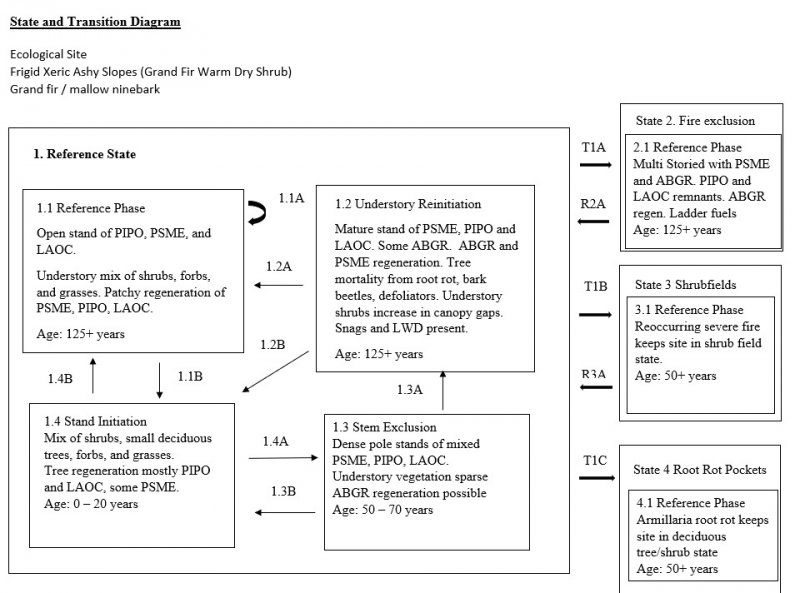
More interactive model formats are also available.
View Interactive Models
More interactive model formats are also available.
View Interactive Models
Click on state and transition labels to scroll to the respective text
Ecosystem states
State 1 submodel, plant communities
State 2 submodel, plant communities
State 3 submodel, plant communities
State 4 submodel, plant communities
State 1
Reference
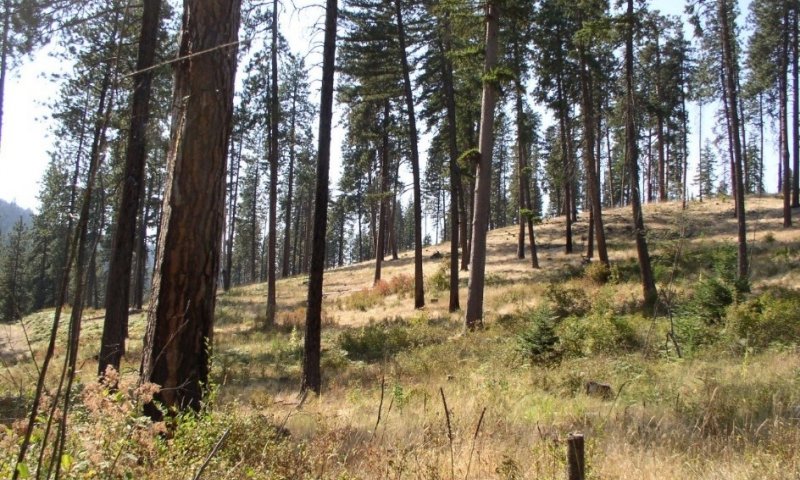
Frequent ground fires every 10 – 20 years create an open stand of mature ponderosa pine, western larch, and some Douglas-fir. Understory is a mix of grass and shrubs. Most of the scattered regeneration is pine and larch with some Douglas-fir and grand fir. Most of the herb component is pine grass with scattered ninebark, oceanspray, and snowberry. With infrequent fire the mature stand becomes denser and Douglas-fir and grand fir regeneration increases. Fire exclusion (State 2) for several years creates a multi-story Douglas-fir –grand fir stand with remnant pine and larch. Stands in this condition are more susceptible to stand replacing fires. Amillaria root rot mortality (State 4) can increase in Douglas-fir and grand fir creating deciduous tree/shrub pockets. Severe fires can lead to shrub dominated areas for long time periods (State 3).
Dominant plant species
-
Rocky Mountain Douglas-fir (Pseudotsuga menziesii var. glauca), tree
-
western larch (Larix occidentalis), tree
-
ponderosa pine (Pinus ponderosa), tree
-
grand fir (Abies grandis), tree
-
oceanspray (Holodiscus discolor), shrub
-
mallow ninebark (Physocarpus malvaceus), shrub
-
dwarf rose (Rosa gymnocarpa), shrub
-
Saskatoon serviceberry (Amelanchier alnifolia), shrub
-
white spirea (Spiraea betulifolia), shrub
-
Oregon boxleaf (Paxistima myrsinites), shrub
-
Rocky Mountain maple (Acer glabrum), shrub
-
Columbia brome (Bromus vulgaris), grass
-
pinegrass (Calamagrostis rubescens), grass
-
Geyer's sedge (Carex geyeri), grass
-
American trailplant (Adenocaulon bicolor), other herbaceous
-
starry false lily of the valley (Maianthemum stellatum), other herbaceous
-
Idaho goldthread (Coptis occidentalis), other herbaceous
-
sweetcicely (Osmorhiza berteroi), other herbaceous
-
Oregon drops of gold (Prosartes hookeri var. oregana), other herbaceous
-
Piper's anemone (Anemone piperi), other herbaceous
-
white hawkweed (Hieracium albiflorum), other herbaceous
Community 1.1
Reference Plant Community – Open Stand

This phase would be considered the historical plant community. Frequent low severity fires create an open stand of mostly large diameter 100+ year old ponderosa pine and western larch with some Douglas-fir. Tree regeneration is patchy consisting mainly of ponderosa pine, western larch with some Douglas-fir. Understory vegetation is a mix of shrubs, forbs and grasses (Open stand – Forest Restoration – Tree Removal and Burning)
Dominant plant species
-
Rocky Mountain Douglas-fir (Pseudotsuga menziesii var. glauca), tree
-
western larch (Larix occidentalis), tree
-
ponderosa pine (Pinus ponderosa), tree
-
grand fir (Abies grandis), tree
-
oceanspray (Holodiscus discolor), shrub
-
mallow ninebark (Physocarpus malvaceus), shrub
-
dwarf rose (Rosa gymnocarpa), shrub
-
Saskatoon serviceberry (Amelanchier alnifolia), shrub
-
white spirea (Spiraea betulifolia), shrub
-
Oregon boxleaf (Paxistima myrsinites), shrub
-
Rocky Mountain maple (Acer glabrum), shrub
-
Columbia brome (Bromus vulgaris), grass
-
pinegrass (Calamagrostis rubescens), grass
-
Geyer's sedge (Carex geyeri), grass
-
American trailplant (Adenocaulon bicolor), other herbaceous
-
starry false lily of the valley (Maianthemum stellatum), other herbaceous
-
Idaho goldthread (Coptis occidentalis), other herbaceous
-
sweetcicely (Osmorhiza berteroi), other herbaceous
-
Oregon drops of gold (Prosartes hookeri var. oregana), other herbaceous
-
Piper's anemone (Anemone piperi), other herbaceous
-
white hawkweed (Hieracium albiflorum), other herbaceous
Community 1.2
Understory Reinitiation
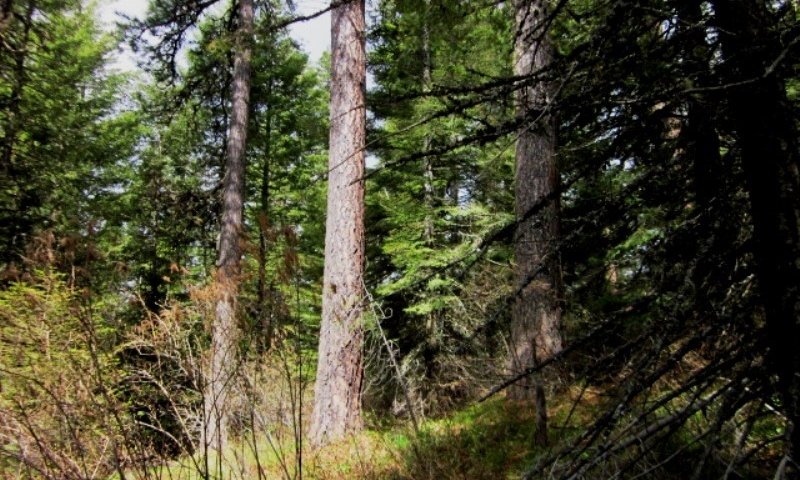
Mixed stand of mature ponderosa pine, western larch and Douglas-fir. Canopy gaps from tree mortality increase shrub understory. Douglas-fir and grand fir regeneration present. Bark beetle and root rot hazard increases. Snags and downed wood present. Ninebark, oceanspray, snowberry, and Douglas-maple key understory shrubs. Mixed severity fires and ground fires open up stand and create a patchy mosaic of openings for pine, larch, and Douglas-fir regeneration mixed with grass and shrubs.
Dominant plant species
-
Rocky Mountain Douglas-fir (Pseudotsuga menziesii var. glauca), tree
-
ponderosa pine (Pinus ponderosa), tree
-
western larch (Larix occidentalis), tree
-
grand fir (Abies grandis), tree
-
mallow ninebark (Physocarpus malvaceus), shrub
-
oceanspray (Holodiscus discolor), shrub
-
common snowberry (Symphoricarpos albus), shrub
-
pinegrass (Calamagrostis rubescens), grass
Community 1.3
Stem Exclusion
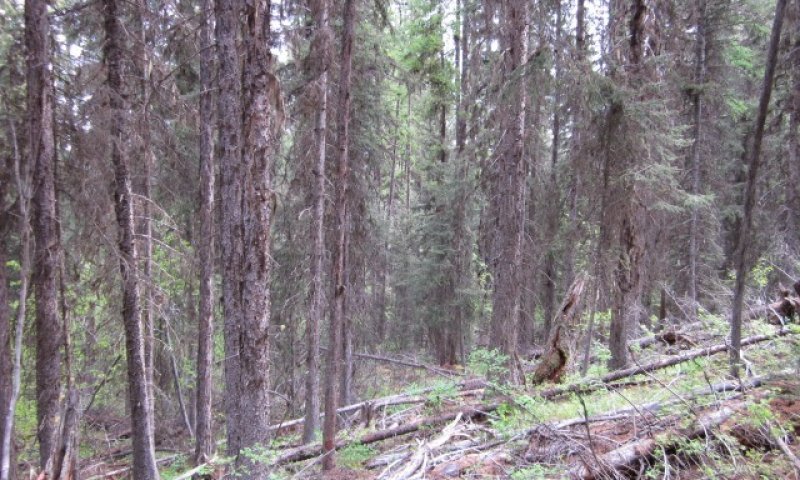
Dense pole stands of pine, larch, and Douglas-fir. Understory sparse. Stand competition make stands susceptible to bark beetle attack. Grand fir regeneration possible in understory.
Dominant plant species
-
Rocky Mountain Douglas-fir (Pseudotsuga menziesii var. glauca), tree
-
ponderosa pine (Pinus ponderosa), tree
-
western larch (Larix occidentalis), tree
-
grand fir (Abies grandis), tree
Community 1.4
Stand Initiation
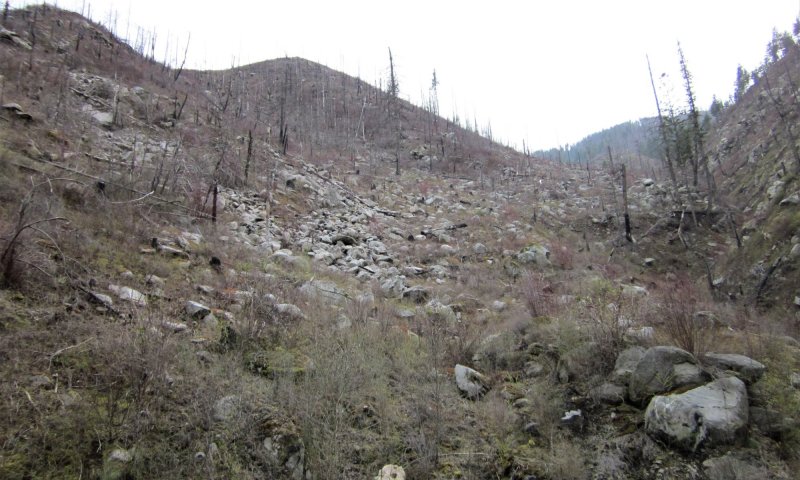
Stand replacing fires create dense shrub fields mixed with grass. Tree regeneration dependent on good seed source. Ponderosa pine and western larch usually most prominent regeneration. Douglas-fir regeneration sporadic. Ceanothus velutinus (snowbrush ceanothus), can dominate the site after fires and limit tree regeneration for 50+ years. Scouler willow and Douglas maple can also be prevalent along with pinegrass and elk sedge.
Dominant plant species
-
ponderosa pine (Pinus ponderosa), tree
-
western larch (Larix occidentalis), tree
-
Rocky Mountain Douglas-fir (Pseudotsuga menziesii var. glauca), tree
-
snowbrush ceanothus (Ceanothus velutinus), shrub
-
Scouler's willow (Salix scouleriana), shrub
-
Rocky Mountain maple (Acer glabrum), shrub
-
common snowberry (Symphoricarpos albus), shrub
-
pinegrass (Calamagrostis rubescens), grass
-
Geyer's sedge (Carex geyeri), grass
Pathway 1.1B
Community 1.1 to 1.4


Stand replacing fire
Pathway 1.2A
Community 1.2 to 1.1


Mixed severity and/or frequent low ground fires open up stand.
Pathway 1.2B
Community 1.2 to 1.4


Stand replacing fire
Pathway 1.3A
Community 1.3 to 1.2


Time. Stand grows to mature stage, canopy gaps occur from overstory mortality.
Pathway 1.3B
Community 1.3 to 1.4


Stand replacing fire.
Pathway 1.4B
Community 1.4 to 1.1


Fire at 10 – 15 year intervals keep stand in open condition.
Pathway 1.4A
Community 1.4 to 1.3


Time. Seedlings/saplings grow to dense pole stage.
State 2
Fire Exclusion
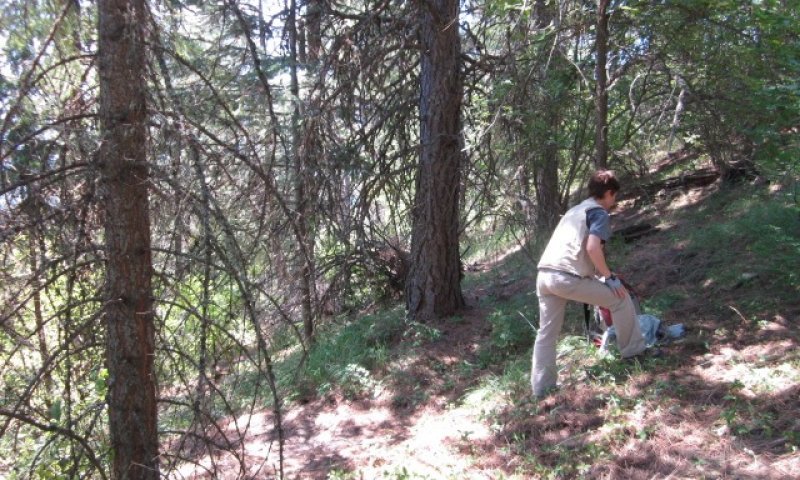
This state develops with extended lack of fire and consists of all aged Douglas-fir and grand fir with scattered old ponderosa pine and western larch remnants. Tree canopy is multi-storied. Tree age ranges from 60-125+ years. Windthrow and root rot pockets create openings for shrub or tree regeneration. Many snags and down logs can be present. High fuel loads and ladder fuels create conditions for stand replacing fire.
Community 2.1
Reference Phase
All aged Douglas-fir and grand fir with scattered old ponderosa pine and western larch remnants. Tree canopy is multi-stored. Tree age ranges from 60-125+ years. Windthrow and root rot pockets create openings for shrub or tree regeneration. Many snags and down logs can be present. High fuel loads and ladder fuels create conditions for stand replacing fire.
State 3
Shrubfields
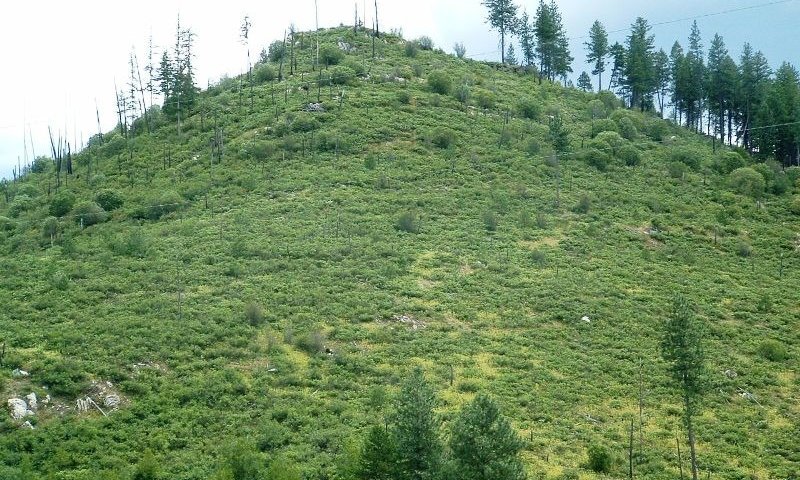
Reoccurring severe fire damages soil surface and shrubs dominate site for extended time period. Tree regeneration is sporadic or nonexistent. Ceanothus species would be a key component in this state. Other shrub species would include snowberry, ninebark, oceanspray, Douglas-maple, and Scouler willow.
Community 3.1
Reference Phase
Tree regeneration is sporadic or nonexistent. Ceanothus species would be a key component in this state. Other shrub species would include snowberry, ninebark, oceanspray, Douglas-maple, and Scouler willow.
Dominant plant species
-
ceanothus (Ceanothus), shrub
-
common snowberry (Symphoricarpos albus), shrub
-
mallow ninebark (Physocarpus malvaceus), shrub
-
oceanspray (Holodiscus discolor), shrub
-
Rocky Mountain maple (Acer glabrum), shrub
-
Scouler's willow (Salix scouleriana), shrub
State 4
Root Rot
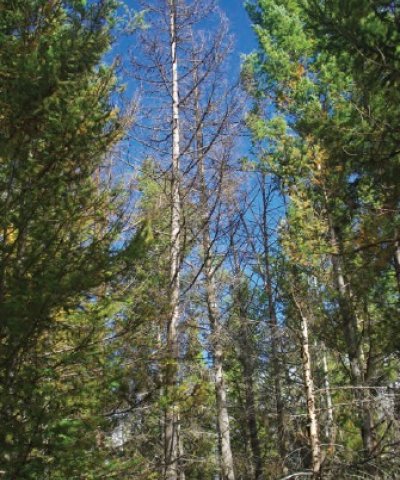
Large to small pockets of Armillaria root rot have killed Douglas-fir and grand fir pole to mature stands leaving site occupied by deciduous trees and shrubs and scattered conifers. Reestablishment to pine, larch, and fir overstory may take over 50 years depending on disturbance or root rot longevity. Ponderosa pine and western larch are more resistant to this root rot, however, seedlings and saplings can be killed. Root rot more severe on warm south and west exposures with metisedimentary and quartzite parent materials and overlying soils with less than 7 inches of volcanic ash (Vitrandic classification). Armillaria root disease causes by the fungus Armillaria ostoyae along with other root diseases such as Laminated root rot (Phellinus weirii) and Annosum root disease (Heterobasidion annosum) kill the overstory Douglas-fir and grand fir creating brush fields of aspen, maple, willow, ninebark, and oceanspray. Sporatic conifer tree regeneration may occur with the susceptibility of the mortality due to root disease. Ponderosa pine and western larch are less susceptible with potential establishment and survival. It may take several years for a mature conifer overstory to dominate these areas depending on the root disease longevity.
Community 4.1
Reference Phase
Armillaria root disease causes by the fungus Armillaria ostoyae along with other root diseases such as Laminated root rot (Phellinus weirii) and Annosum root disease (Heterobasidion annosum) kill the overstory Douglas-fir and grand fir creating brush fields of aspen, maple, willow, ninebark, and oceanspray. Sporadic conifer tree regeneration may occur but is susceptible to mortality due to root disease. Ponderosa pine and western larch are less susceptible with potential establishment and survival. It may take several years for a mature conifer overstory to dominate these areas depending on the root disease longevity.
Dominant plant species
-
ponderosa pine (Pinus ponderosa), tree
-
western larch (Larix occidentalis), tree
-
mallow ninebark (Physocarpus malvaceus), shrub
-
oceanspray (Holodiscus discolor), shrub
-
Scouler's willow (Salix scouleriana), shrub
-
Rocky Mountain maple (Acer glabrum), shrub
Transition T1A
State 1 to 2


Fire Exclusion
Transition T1B
State 1 to 3


Reoccurring severe fire with soil degradation keeping a shrubfield state
Transition T1C
State 1 to 4


Root rot pockets killing DF and GF creating a deciduous vegetation state
Restoration pathway R2A
State 2 to 1


Selective overstory removal with prescribed burning
Restoration pathway R3A
State 3 to 1


Time. Stand grows to mature stage, canopy gaps occur from overstory mortality including mixed severity fire.
Additional community tables
Interpretations
Table 6. Representative site productivity
| Common name | Symbol | Site index low | Site index high | CMAI low | CMAI high | Age of CMAI | Site index curve code | Site index curve basis | Citation |
|---|---|---|---|---|---|---|---|---|---|
| Rocky Mountain Douglas-fir | PSMEG | 75 | 110 | 71 | 160 | 90 | – | – | |
| Rocky Mountain Douglas-fir | PSMEG | 64 | 107 | 65 | 158 | 90 | – | – | |
| ponderosa pine | PIPO | 98 | 120 | 99 | 141 | 40 | – | – | |
| grand fir | ABGR | 70 | 85 | 95 | 124 | 110 | – | – | |
| western larch | LAOC | 66 | 85 | 66 | 103 | 50 | – | – | |
| western larch | LAOC | 50 | 70 | 63 | 70 | 70 | – | – |
Supporting information
References
-
. 1998. NRCS National Forestry Manual.
-
. 2017. NRCS Soil and Site Index data for NE WA and N. Idaho.
-
Cooper, S.V., K.E. Neiman, R. Steele, and D.W. Roberts. 1991. Forest Habitat types of Northern Idaho, A Second Approximation.
-
Daubenmire, R. and J. Daubenmire. 1968. Forest Vegetation of Eastern Washington and Northern Idaho.
-
Finklin, A.I. 1983. Climate of Priest River Experimental Forest, northern Idaho. Gen. Tech. Rep. INT-159. U.S. Department of Agriculture, Forest Service, Intermountain Forest and Range Experiment Station, Ogden, UT. 53.
-
Smith and Fischer. 1997. Fire Ecology of the Forest Habitat Types of Northern Idaho.
-
Williams, C.K., B.F. Kelley, B.G. Smith, and T.R. Lillybridge. October, 1995. Forested Plant Associations of the Colville National Forest.
-
Zack, A. 1997. Biophysical Classification- Habitat Groups and Description of Northern Idaho and Northwestern Montana, Lower Clarkfork and Adjacent Areas..
Approval
Kirt Walstad, 3/11/2025
Rangeland health reference sheet
Interpreting Indicators of Rangeland Health is a qualitative assessment protocol used to determine ecosystem condition based on benchmark characteristics described in the Reference Sheet. A suite of 17 (or more) indicators are typically considered in an assessment. The ecological site(s) representative of an assessment location must be known prior to applying the protocol and must be verified based on soils and climate. Current plant community cannot be used to identify the ecological site.
| Author(s)/participant(s) | |
|---|---|
| Contact for lead author | |
| Date | 12/18/2020 |
| Approved by | Kirt Walstad |
| Approval date | |
| Composition (Indicators 10 and 12) based on | Annual Production |
Indicators
-
Number and extent of rills:
-
Presence of water flow patterns:
-
Number and height of erosional pedestals or terracettes:
-
Bare ground from Ecological Site Description or other studies (rock, litter, lichen, moss, plant canopy are not bare ground):
-
Number of gullies and erosion associated with gullies:
-
Extent of wind scoured, blowouts and/or depositional areas:
-
Amount of litter movement (describe size and distance expected to travel):
-
Soil surface (top few mm) resistance to erosion (stability values are averages - most sites will show a range of values):
-
Soil surface structure and SOM content (include type of structure and A-horizon color and thickness):
-
Effect of community phase composition (relative proportion of different functional groups) and spatial distribution on infiltration and runoff:
-
Presence and thickness of compaction layer (usually none; describe soil profile features which may be mistaken for compaction on this site):
-
Functional/Structural Groups (list in order of descending dominance by above-ground annual-production or live foliar cover using symbols: >>, >, = to indicate much greater than, greater than, and equal to):
Dominant:
Sub-dominant:
Other:
Additional:
-
Amount of plant mortality and decadence (include which functional groups are expected to show mortality or decadence):
-
Average percent litter cover (%) and depth ( in):
-
Expected annual annual-production (this is TOTAL above-ground annual-production, not just forage annual-production):
-
Potential invasive (including noxious) species (native and non-native). List species which BOTH characterize degraded states and have the potential to become a dominant or co-dominant species on the ecological site if their future establishment and growth is not actively controlled by management interventions. Species that become dominant for only one to several years (e.g., short-term response to drought or wildfire) are not invasive plants. Note that unlike other indicators, we are describing what is NOT expected in the reference state for the ecological site:
-
Perennial plant reproductive capability:
Print Options
Sections
Font
Other
The Ecosystem Dynamics Interpretive Tool is an information system framework developed by the USDA-ARS Jornada Experimental Range, USDA Natural Resources Conservation Service, and New Mexico State University.
Click on box and path labels to scroll to the respective text.